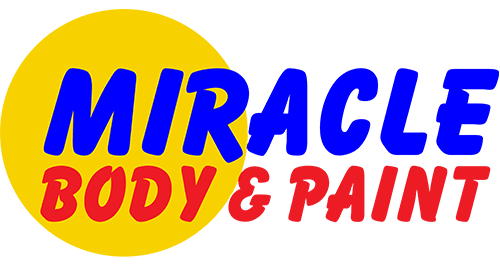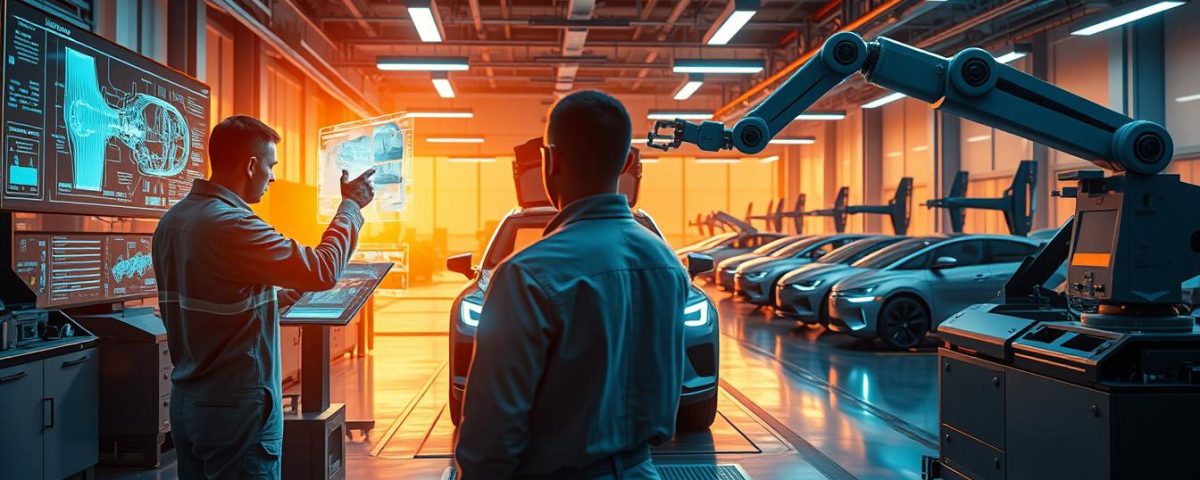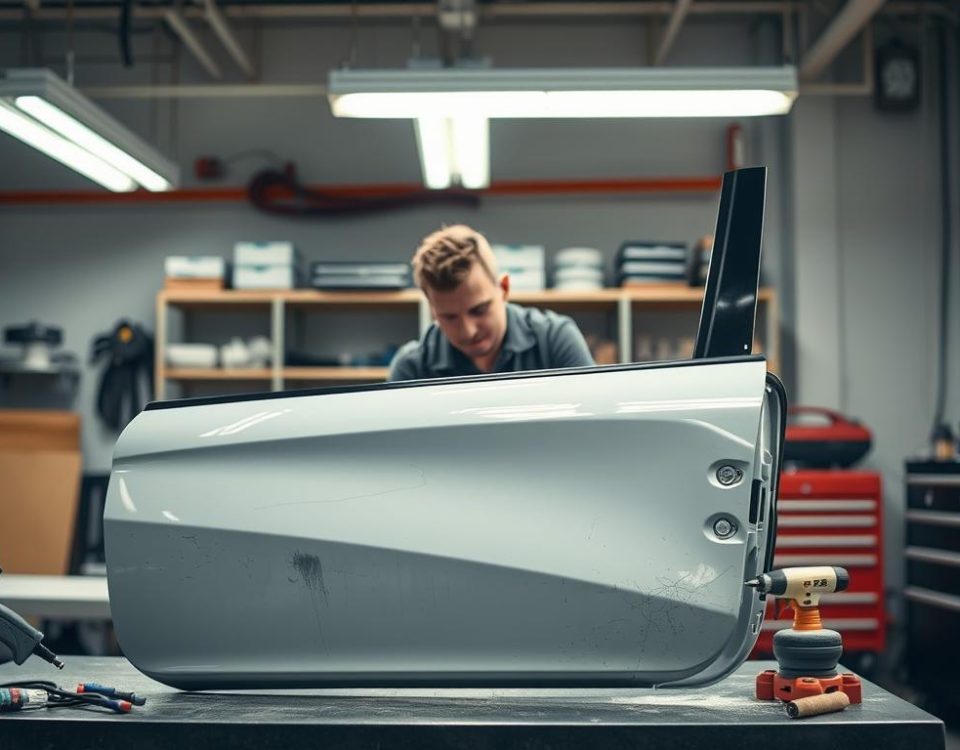
How to Read Auto Body Shop Reviews Before Choosing One
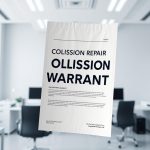
Understanding Your Collision Repair Warranty
By 2025, your auto body repair experience looks very different. Shops now use AI estimates, ADAS calibration, and EV safety protocols to make decisions that used to rely on guesswork. This shift raises safety and consistency across the industry while speeding up repairs.
Data-driven tools like 3D scanning, spectrophotometer paint matching, and on-demand 3D printing cut delays and reduce rework. VIN-scrubbed parts ordering and electronic workflows keep parts flowing and paperwork clean. Customers get 24/7 digital access for scheduling, photo estimates, and real-time updates.
Miracle Body and Paint embraces these advances to deliver quality repairs for your cars. Our shops pair greener refinish systems and AR/VR training for technicians to improve outcomes while lowering environmental impact. For repairs done right, hire Miracle Body and Paint at either San Antonio location: North West San Antonio – Leon Valley (210) 680-1987, 6217 Grissom Rd., San Antonio, TX 78238; North East San Antonio (210) 858-3630, 4650 Walzem Rd, San Antonio, TX 78218.
Key Takeaways
- AI estimates and OEM procedures now guide accurate repair plans.
- EV protocols and ADAS calibration are central to safety and quality.
- 3D scanning and automated paint matching speed repairs and cut rework.
- Digital tools give customers 24/7 access to updates and scheduling.
- VIN-scrubbed parts ordering and analytics improve parts flow and throughput.
The 2025 collision repair landscape: smarter vehicles, smarter shops
Repair work today demands exact processes to protect the complex systems built into newer vehicles. You’re driving cars loaded with sensors, cameras, and connected systems, so shops must match that sophistication with calibrated processes to preserve safety and function.
Smart shops use AI to triage damage and speed diagnostics. ADAS integration now requires precise calibration to meet OEM specs. EVs require strict high-voltage safety, special tooling, and trained battery handling to avoid risks.
New materials like aluminum and carbon fiber need dedicated bays and non-traditional joining methods. Environmental stewardship also shapes work through waterborne paints, low-VOC products, and energy-efficient booths.
- Data-driven scheduling and WIP management reduce bottlenecks and cut cycle time.
- 24/7 digital access gives you on-demand scheduling and real-time updates.
- Continuous upskilling keeps technicians certified for evolving systems and auto repair tasks.
Miracle Body and Paint Collision Center pairs smart systems with skilled technicians to deliver safe, high-quality repair—call NW Leon Valley (210) 680-1987 or NE Walzem (210) 858-3630 to get started.
AI-driven damage assessment reshapes estimates, cycle time, and cost transparency
Machine learning transforms a few photos into a detailed repair blueprint and timeline. AI analyzes images to find visible and subtle damage, giving you a fast, evidence-backed starting point for the repair process.
Computer vision flags panel distortion, sensor misalignment, and other issues that manual checks may miss. That data speeds blueprinting and helps technicians prioritize diagnostics.
Computer vision and machine learning for instant triage and blueprinting
Submit photos for rapid AI triage so the shop can open a preliminary plan right away. Integrated models push accurate line items into the shop management system, reducing surprises later.
Seamless integrations with shop management systems and insurers
- AI exports itemized estimates to insurers, cutting supplement disputes.
- WIP and scheduling use historical data to trim cycle time and improve throughput.
- Evidence-based plans shrink variance between shop and insurer price expectations.
From photo-based estimates to accurate, data-backed repair plans
You get clearer price breakdowns and real-time updates during repairs. For transparent, AI-informed estimates and clear communication, hire Miracle Body and Paint assessment services: Leon Valley (210) 680-1987; Walzem (210) 858-3630.
ADAS calibration moves center stage in the repair process
Modern safety systems require exact calibration steps to restore proper function after repairs. ADAS modules are part of the vehicle’s safety fabric, so precise work prevents warnings, false triggers, or system shutdowns.
Static calibration uses targets in a controlled bay with set lighting and verified distances. It suits glass replacement, bumper work, and sensor swaps where manufacturer specs call for fixed conditions.
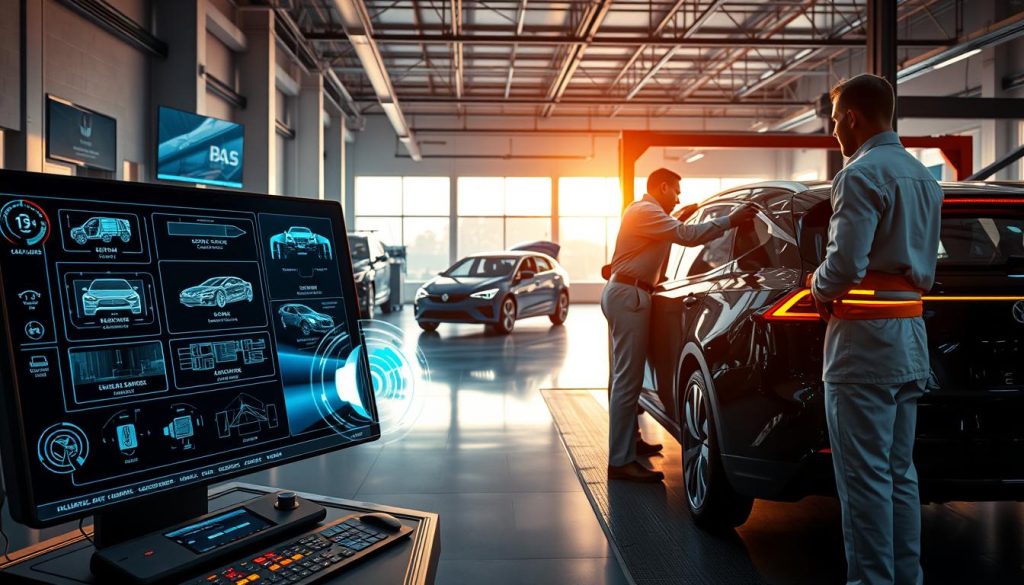
Static vs. dynamic calibration: when and why each method matters
Dynamic calibration happens on the road during test drives. It verifies lane assist, radar, and camera behavior under real driving loads. OEM procedures determine which method is required for your repair.
Sensor, radar, and camera alignment to meet OEM safety specs
Correct equipment setup and calibrated targets are essential. Radar, lidar, ultrasonic sensors, and cameras need realignment after collisions, glass replacement, or suspension work.
- Defined steps ensure post-repair test drives clear diagnostic trouble codes.
- Trained technicians verify safety features and document scan reports for proof.
- Coordinating wheel alignment and suspension repairs avoids redundant work and speeds delivery.
Ensure your vehicle’s ADAS is calibrated correctly. Schedule with Miracle Body and Paint Collision Center: NW (210) 680-1987 or NE (210) 858-3630 for safe, OEM-compliant repair and documented results.
AI Damage Assessment Enhances Estimates, Speed & Cost Transparency
Electric drivetrains demand distinct repair steps to keep high-voltage systems safe and functional. You should expect shops to follow clear lockout/tagout procedures and documented depower steps before any work begins.
Specialized training and the right equipment protect your car and the team. Insulated tools, EV-safe lifts, and personal protective gear are baseline requirements for safe repair work on battery-powered vehicles.
Battery isolation, safe power-down, and insulated tooling requirements
Proper battery isolation reduces the risk of thermal runaway and keeps sensitive electronics intact during structural repairs.
You benefit from strict high-voltage lockout/tagout, documented depower/re-power steps, and the use of insulated tools that limit arcing and accidental shorts.
Repairing EV structures and thermal systems without compromising safety
Trained technicians follow OEM methods for battery trays, cooling circuits, and underbody structures. EV-specific bonding and riveting often replace legacy welding in aluminum and composite areas.
Documentation of each step verifies system health and supports warranty compliance. For high-voltage-safe repairs, choose Miracle Body and Paint Collision Center. Call Leon Valley (210) 680-1987 or Walzem (210) 858-3630.
- Insulated tools, PPE, and EV lifts protect teams and vehicles.
- OEM-aligned methods preserve performance and warranty.
- Battery isolation and cooling checks reduce thermal risk.
| Area | Required Measures | Why it matters | Outcome |
|---|---|---|---|
| Battery Isolation | Lockout/tagout, documented depower | Prevents live circuits and thermal events | Safer diagnostics and reassembly |
| Insulated Tools | EV-rated hand tools and PPE | Reduces arcing and accidental shorts | Protects components and staff |
| Structural Repair | Bonding, riveting, OEM repair methods | Maintains strength in aluminum/composites | Restores crash performance |
| Thermal Systems | Coolant circuit checks, sensor routing | Avoids overheating and performance loss | Reliable thermal management after repair |
Advanced materials transform body work, tooling, and repair methods
Mixed metals and advanced composites now demand purpose-built bays, tailored tooling, and precise joining methods.
Aluminum bays, rivets, bonding, and weld alternatives
You want repairs done without causing new problems. Dedicated aluminum bays prevent steel contamination and reduce galvanic corrosion risks.
Shops use non-ferrous tools and specific equipment for riveting, flow-drill fasteners, and controlled weld alternatives. Heat control and adhesive cure profiles are critical steps to keep strength and durability.
Carbon fiber and composites: repair vs. replace
Some composites are repairable, others must be replaced per OEM thresholds. You’ll decide based on load paths, delamination extent, and manufacturer guidance.
OEM procedures as the roadmap for structural integrity
Follow OEM steps for sectioning locations, fastener specs, and straightening limits. Accurate jigs, measurements, and post-repair corrosion protection return your vehicle to factory standards.
- Aluminum bays prevent cross-contamination and corrosion.
- Specialized tools and fixtures enable precise bonding and riveting.
- OEM-approved steps preserve crash energy management and safety.
| Material | Required Measures | Why it matters |
|---|---|---|
| Aluminum | Non-ferrous tools, dedicated bay, adhesive cure control | Prevents galvanic corrosion and maintains strength |
| Carbon fiber | OEM repair thresholds, controlled bonding, replace when delaminated | Ensures structural integrity and crash performance |
| Advanced steels | Heat-controlled straightening, torque-specified fasteners | Preserves material yield and crash energy paths |
For aluminum, high-strength steel, and composite repairs done right, contact Miracle Body and Paint Collision Center: NW (210) 680-1987; NE (210) 858-3630.
Sustainable repair methods and next-gen refinish systems
Shops are adopting greener refinish systems that cut emissions and speed cure times. These changes lower environmental impact while keeping finishes durable and color-accurate.
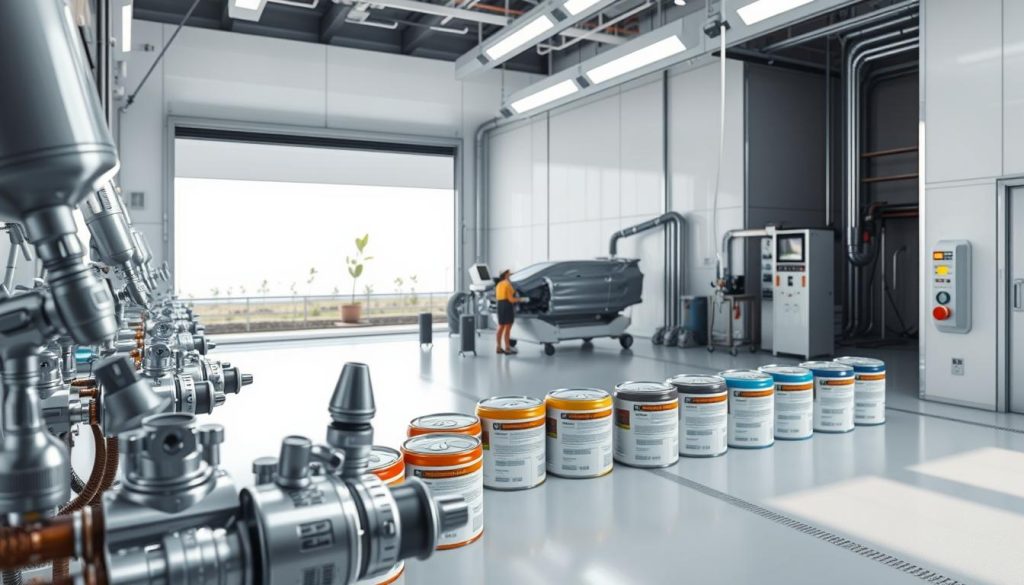
Waterborne paint systems, low-VOC products, and efficient equipment
Water-based paint and low-VOC clearcoats reduce fumes and improve air quality for your community. Energy-efficient booths and modern compressors shorten bake cycles and trim power use.
Smart repair techniques that reduce waste and environmental impact
Targeted panel repair and precise color tools cut material use and repaint cycles. That saves resources and speeds turnaround for your repairs.
- You benefit from waterborne basecoats and low-VOC products that reduce harmful emissions.
- Energy-efficient booths and compressors improve cycle time and operational efficiency.
- Smart repair methods minimize landfill waste and lower total cost of ownership.
- Documentation of greener methods supports insurer and OEM programs and reassures customers.
For eco-conscious refinishing and efficient repairs, contact Miracle Body and Paint Collision Center at Leon Valley (210) 680-1987 or Walzem (210) 858-3630 for visible, certified green practices.
Data analytics in collision repair: from estimates to operations
Data-driven scheduling and analysis change how your vehicle moves through the shop. AI models and historical records help teams set WIP limits, predict bottlenecks, and shorten overall cycle time.
Repair shops aggregate estimate, parts, and cycle data to create reliable schedules. Telematics and pre/post scans confirm diagnostics, so work steps are evidence-based and repeatable.
- You get more accurate timelines when repair shops use historical data to predict bottlenecks and set WIP limits.
- Analytics reveal ideal scheduling windows and technician loading to reduce idle time and raise efficiency.
- Telematics and pre/post-repair scans validate fault codes cleared and systems restored for documented outcomes.
- Parts usage trends inform smarter ordering and stocking, cutting delays and supplement cycles.
- KPI dashboards track touch time, cycle time, and throughput so the whole process improves continuously.
For data-backed scheduling and validated diagnostics, choose Miracle Body and Paint Collision Center: NW (210) 680-1987; NE (210) 858-3630. Expect clearer timelines and evidence-based repairs when systems are connected end-to-end.
Supply chain technology solutions streamline parts and cycle times
Modern supply platforms link VIN data to parts catalogs so you get the right component the first time.
VIN-scrubbed electronic ordering reduces mis-matches and the need for supplements. Real-time warehouse feeds show when parts are available, so your vehicle is scheduled only when components are on hand.
VIN-scrubbed ordering and live inventory
When orders match a VIN, you cut returns and speed fulfillment. Shops rely on live inventory to plan bay time and avoid last-minute delays.
Automated credits and e-invoicing
E-invoicing exports clean data to shop management systems and speeds insurer approvals. Automated credit tracking stops accounting holds that can stall delivery.
- You see fewer supplements with electronic VIN matching.
- Real-time inventory makes repair dates more reliable.
- Clear electronic quotes improve price transparency and reduce substitutions.
| Feature | Benefit | Outcome |
|---|---|---|
| VIN-scrubbed orders | Correct part first time | Fewer returns, faster cycle time |
| Live warehouse visibility | Accurate scheduling | Predictable delivery dates |
| E-invoicing & credits | Fewer manual errors | Quicker approvals and releases |
| Systems integration | End-to-end transparency | Higher trust across the industry |
For fast, accurate parts sourcing and fewer delays, book with Miracle Body and Paint Collision Center: Leon Valley (210) 680-1987; Walzem (210) 858-3630.
3D scanning, automated paint matching, and 3D printing accelerate precision
High-resolution 3D scans capture your vehicle’s exact geometry in minutes, creating a reliable baseline for alignment and fit. These scans remove guesswork and speed approval for structural work.
Full-vehicle dimensional scans for accurate measurements and alignments
Full-vehicle scans provide exact panel locations, gap data, and frame geometry. You get precise alignment numbers without long manual measuring.
Precise tools integrate scan data with jig systems so technicians restore factory specs faster. Scans also shorten diagnostics and reduce rework.
Spectrophotometer paint matching and on-demand additive parts fabrication
Spectrophotometers read complex tones and create formulas that deliver uniform color across panels and blends.
On-demand 3D printing supplies brackets, clips, and trim when OEM parts delay your job. Additive parts save time and cost for non-safety-critical components while keeping fit and finish high.
- You get exact panel fitment and alignment from full-vehicle 3D dimensional scans.
- Spectrophotometer-based color formulas ensure paint uniformity and better finish quality.
- On-demand printing delivers small parts quickly, cutting lead times for repairs.
- These combined technologies raise consistency and reduce comebacks for your car.
For showroom-level fit and finish, contact Miracle Body and Paint Collision Center: NW (210) 680-1987; NE (210) 858-3630. Schedule precision-driven repairs today.
Advanced diagnostics and connected systems improve accuracy and safety
Modern diagnostics give technicians a clear map of a vehicle’s health before any panels come off.
Pre- and post-repair scans, live health data, and evidence-based decisions
Pre-repair scans map fault codes and visible damage so estimates match real needs. You get a clear baseline that guides each repair step.
Live data streams help technicians isolate problems quickly. That reduces exploratory disassembly and cuts wasted labor.
After work, post-repair scans verify that safety systems and comfort controls are restored. Documented steps provide proof for you and insurers.
- You receive pre-repair scans that map system faults and guide estimate accuracy.
- Live data helps teams pinpoint problems and protect modules from unnecessary swaps.
- Post-repair scans confirm function and reduce return visits.
| Diagnostic Step | Purpose | Outcome |
|---|---|---|
| Pre-repair scan | Map faults and visible damage | Accurate estimate and plan |
| Live health monitoring | Isolate failing modules | Less disassembly, faster fix |
| Post-repair verification | Confirm restored systems | Documented safety and quality |
Get scan-verified accuracy with Miracle Body and Paint Collision Center. Call Leon Valley (210) 680-1987 or Walzem (210) 858-3630 to book your vehicle repair.
Digital training and education: AR/VR simulations and OEM-aligned learning
Immersive simulations give technicians real-feel practice without risking your vehicle. These tools let your team rehearse complex steps and master torque specs before any disassembly begins.
Immersive repair practice for complex procedures without risk
AR and VR labs let technicians run full procedures in a realistic setting. You benefit because mistakes happen in the simulation, not on your car.
Certification tracking, tool updates, and remote coaching at scale
Modern software tracks expiring certifications and pushes tool updates that affect safety. Remote coaching connects experts to a job in real time, so your team gets oversight when it matters.
- You get better outcomes when technicians train on complex repairs in AR/VR before touching your vehicle.
- OEM-aligned modules ensure procedures and torque specs are followed precisely for higher quality.
- Remote coaching and certification tracking keep the shop current and reduce rework.
- Microlearning shortens the path from training to on-the-job proficiency and raises craftsmanship.
Choose a shop that invests in continuous learning—Miracle Body and Paint Collision Center. NW (210) 680-1987; NE (210) 858-3630.
Always-on customer experience: mobile repair services and digital care
Online scheduling and AI chat now put service control in your hands 24/7. You can book appointments from your phone or a desktop at any hour. That saves you time and avoids long hold times.
AI chat answers common questions, helps with basic estimates, and can dispatch a tow when you need help fast. For small fixes, select mobile services come to your location and handle minor repairs for your car.

24/7 scheduling, AI chat, and mobile capabilities that save you time
Digital authorizations and e-signatures speed approvals so work starts sooner. Transparent updates reduce surprises and build trust with the shop.
- You can schedule anytime online and receive status updates without phone tag.
- AI chat helps with estimating, FAQs, and coordinating tows when you need help fast.
- Select mobile services handle minor repairs at your location, saving you time.
Data privacy matters. Shops must safeguard your information and avoid oversharing images. Streamlined feedback reduces survey fatigue while still capturing your voice.
| Feature | Benefit | Customer outcome |
|---|---|---|
| 24/7 online booking | Access on your schedule | Less waiting, faster start times |
| AI chat & digital authorizations | Immediate answers and faster approvals | Reduced delays and clearer expectations |
| Mobile service options | On-site minor repairs | Save travel time and get back on the road sooner |
| Privacy & streamlined feedback | Fewer intrusive surveys, secure data handling | Better satisfaction and protected personal info |
Save time with easy booking and updates. Hire Miracle Body and Paint Collision Center for an always-on experience: Leon Valley (210) 680-1987; Walzem (210) 858-3630.
Collision center technology: what it means for you in 2025
Today’s repair shops pair standardized electronic workflows with real-time scans to give you clearer timelines and safer outcomes. Industry experts now push transparency and uniform processes so every job follows OEM rules, documented steps, and verified tests.
Safer repairs, higher quality, faster turnaround, and clearer pricing
You can expect safer repairs when ADAS calibration, dimensional scans, and OEM procedures are non-negotiable. Quality rises as shops align training, tools, and materials to modern vehicles.
Faster turnaround comes from AI triage, accurate parts sourcing, and optimized scheduling. Clearer pricing grows with data-backed estimating and electronic reconciliation among parties.
Trust, privacy, and collaboration among shops, insurers, and suppliers
- Collaboration across repair shops, insurers, and suppliers reduces friction and delays.
- Standardizing one-time-use parts identification prevents missed replacements.
- Network equipment updates safeguard repair quality at scale across the repair industry.
- Body shops that protect privacy and data earn your trust and loyalty.
- Transparent communication keeps you informed about features restored and tests performed on your vehicles.
| Area | What it means for you | Customer outcome |
|---|---|---|
| Estimate reconciliation | Electronic line-item matching between shops and insurers | Fewer disputes and faster approvals |
| Parts visibility | VIN-scrubbed ordering and live inventory feeds | Predictable schedules and fewer delays |
| Equipment updates | Networked calibration and firmware management | Consistent repair quality across shops |
Expect safer, faster, clearer outcomes. For trusted service, hire Miracle Body and Paint Collision Center: NW (210) 680-1987; NE (210) 858-3630.
Conclusion
A modern repair model pairs smart diagnostics with hands-on skill to give you safer, faster outcomes for your car.
Ready to put 2025’s best practices to work? You get AI-assisted estimates, ADAS calibration, EV-safe protocols, greener refinishing, VIN-accurate parts workflows, and AR/VR-trained technicians all focused on quality.
These upgrades mean fewer surprises, better fit-and-finish, and verified safety features when your vehicle returns to the road.
Choose Miracle Body and Paint, a trusted repair shop with local service and documented processes—call North West San Antonio – Leon Valley (210) 680-1987 or North East San Antonio (210) 858-3630.

